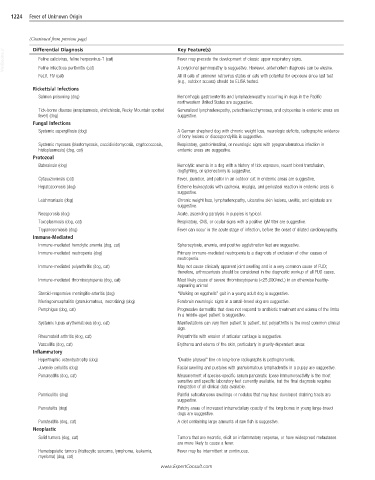Page 2467 - Cote clinical veterinary advisor dogs and cats 4th
P. 2467
1224 Fever of Unknown Origin
(Continued from previous page)
VetBooks.ir Differential Diagnosis Key Feature(s)
Feline calicivirus, feline herpesvirus-1 (cat)
Fever may precede the development of classic upper respiratory signs.
A polyclonal gammopathy is suggestive. However, antemortem diagnosis can be elusive.
Feline infectious peritonitis (cat)
FeLV, FIV (cat) All ill cats of unknown retrovirus status or cats with potential for exposure since last test
(e.g., outdoor access) should be ELISA tested.
Rickettsial Infections
Salmon poisoning (dog) Hemorrhagic gastroenteritis and lymphadenopathy occurring in dogs in the Pacific
northwestern United States are suggestive.
Tick-borne disease (anaplasmosis, ehrlichiosis, Rocky Mountain spotted Generalized lymphadenopathy, petechiae/ecchymoses, and cytopenias in endemic areas are
fever) (dog) suggestive.
Fungal Infections
Systemic aspergillosis (dog) A German shepherd dog with chronic weight loss, neurologic deficits, radiographic evidence
of bony lesions or discospondylitis is suggestive.
Systemic mycoses (blastomycosis, coccidioidomycosis, cryptococcosis, Respiratory, gastrointestinal, or neurologic signs with pyogranulomatous infection in
histoplasmosis) (dog, cat) endemic areas are suggestive.
Protozoal
Babesiosis (dog) Hemolytic anemia in a dog with a history of tick exposure, recent blood transfusion,
dogfighting, or splenectomy is suggestive.
Cytauxzoonosis (cat) Fever, jaundice, and pallor in an outdoor cat in endemic areas are suggestive.
Hepatozoonosis (dog) Extreme leukocytosis with cachexia, myalgia, and periosteal reaction in endemic areas is
suggestive.
Leishmaniasis (dog) Chronic weight loss, lymphadenopathy, ulcerative skin lesions, uveitis, and epistaxis are
suggestive.
Neosporosis (dog) Acute, ascending paralysis in puppies is typical.
Toxoplasmosis (dog, cat) Respiratory, CNS, or ocular signs with a positive IgM titer are suggestive.
Trypanosomiasis (dog) Fever can occur in the acute stage of infection, before the onset of dilated cardiomyopathy.
Immune-Mediated
Immune-mediated hemolytic anemia (dog, cat) Spherocytosis, anemia, and positive agglutination test are suggestive.
Immune-mediated neutropenia (dog) Primary immune-mediated neutropenia is a diagnosis of exclusion of other causes of
neutropenia.
Immune-mediated polyarthritis (dog, cat) May not cause clinically apparent joint swelling and is a very common cause of FUO;
therefore, arthrocentesis should be considered in the diagnostic workup of all FUO cases.
Immune-mediated thrombocytopenia (dog, cat) Most likely cause of severe thrombocytopenia (<25,000/mcL) in an otherwise healthy-
appearing animal
Steroid-responsive meningitis-arteritis (dog) “Walking on eggshells” gait in a young adult dog is suggestive.
Meningoencephalitis (granulomatous, necrotizing) (dog) Forebrain neurologic signs in a small-breed dog are suggestive.
Pemphigus (dog, cat) Progressive dermatitis that does not respond to antibiotic treatment and edema of the limbs
in a middle-aged patient is suggestive.
Systemic lupus erythematosus (dog, cat) Manifestations can vary from patient to patient, but polyarthritis is the most common clinical
sign.
Rheumatoid arthritis (dog, cat) Polyarthritis with erosion of articular cartilage is suggestive.
Vasculitis (dog, cat) Erythema and edema of the skin, particularly in gravity-dependent areas
Inflammatory
Hypertrophic osteodystrophy (dog) “Double physeal” line on long-bone radiographs is pathognomonic.
Juvenile cellulitis (dog) Facial swelling and pustules with granulomatous lymphadenitis in a puppy are suggestive.
Pancreatitis (dog, cat) Measurement of species-specific serum pancreatic lipase immunoreactivity is the most
sensitive and specific laboratory test currently available, but the final diagnosis requires
integration of all clinical data available.
Panniculitis (dog) Painful subcutaneous swellings or nodules that may have developed draining tracts are
suggestive.
Panosteitis (dog) Patchy areas of increased intramedullary opacity of the long bones in young large-breed
dogs are suggestive.
Pansteatitis (dog, cat) A diet containing large amounts of raw fish is suggestive.
Neoplastic
Solid tumors (dog, cat) Tumors that are necrotic, elicit an inflammatory response, or have widespread metastases
are more likely to cause a fever.
Hematopoietic tumors (histiocytic sarcoma, lymphoma, leukemia, Fever may be intermittent or continuous.
myeloma) (dog, cat)
www.ExpertConsult.com

